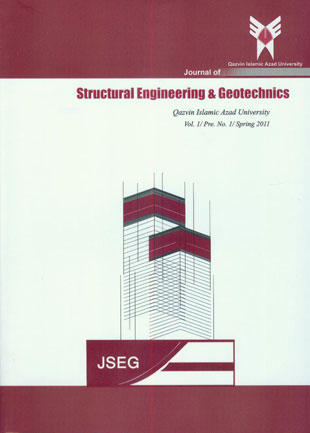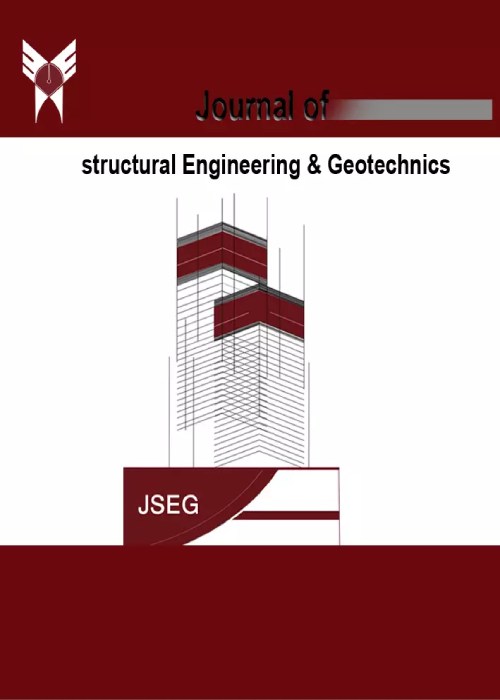فهرست مطالب

Journal of the Structural Engineering and Geotechnics
Volume:1 Issue: 1, Summer 2011
- 74 صفحه،
- تاریخ انتشار: 1390/12/01
- تعداد عناوین: 8
-
Page 1Excess pore pressure under seismic loadings has always been a main concern in geotechnical engineering practices. The phenomenon in soil can cause an effective stress and hence cause the shear strength of the soil to decrease considerably and large deformations to occur in the area. Generally, increases in pore pressure occur in un-drained conditions. If it is formed, its consequences decrease seriously. There are several reports on devastations caused by excess pore pressure in the surrounding soil of the underground structures. As stresses and deformations of the tunnel lining increase, the surrounding soil of the tunnel is liquefied and large deformations become observable. If an increase in the pore pressure occurs in the surrounding soil of the tunnel, which is an improvement of the surrounding area of the tunnel, then stresses and deformations should be set on the allowable limit. Therefore, evaluation of excessive pore pressure effects on the tunnel lining can be regarded as an important issue and this paper is designed to focus on precisely this topic.
-
Page 7The paper will provide a summary of all lifelines performance in this strong earthquake. The paper will discuss the damage, emergency response, and recovery of electric power, telecommunication, transportation (roads and bridges), seaports, airports, water and wastewater, and their facilities. The impact as a result of the lifelines service interruption will be discussed; most important is the discussion of lifelines interdependence. Each lifeline will be separated into its own section that presents the failure modes, emergency response, and recovery of service. Each section will end with observations and recommendations.
-
Page 19The sustainability of the built environment is increasingly coming to the forefront of infrastructure design and maintenance decisions. To address this, development of a new class of more sustainable cement-based materials is needed. Fiber reinforced self-consolidating mortar (FRSCM) was developed by optimizing the micromechanical parameters, which control composite properties in the hardened state, and the processing parameters, which control the rheological properties in the fresh state. The addition of fibers may take advantage of its high performance in the fresh state to achieve a more uniform dispersion of fibers, which can help to mitigate the shrinkage of the self-consolidating composite. In other words, fibers can have rheological and mechanical synergistic effects and that optimized fiber combinations can better increase mechanical performance while maintaining adequate flow properties for fiber reinforced self-consolidating mortar. In this study, effects of aspect ratio (l/d) and volume fraction (Vf) of polypropylene (PP) fiber on the free shrinkage and mechanical properties of FRSCM were investigated. Besides, the rheological properties of fiber reinforced SCMs are investigated by mini-slump and mini V-funnel tests. Nine mortar mixtures are prepared containing 0 to 0.7 percent of 6 and 12 mm length polypropylene fibers. The shrinkages of hardened mortar were measured since removing the molds and the measurements were continued up to six months. The results show that, the optimum volume fraction of polypropylene fiber content in SCMs to achieve appropriate rheological and mechanical properties is about 0.3% of the mixture volume. On the other hand, increasing the volume fraction and aspect ratio of PP fibers to about 0.7% causes the mechanical properties to drop considerably. This could be due to balling of fibers or fibers coagulation in the mixtures which decreases the mechanical properties.
-
Page 27Dynamic compaction (DC) is a widely used soil improvement method in dry and/or saturated soils. The design of DC treatment is usually carried out based on the past experiences and empirical relations. In order to clarify the ambiguities in DC processes, numerical modeling of DC in dry granular soils has been considered using a dynamic finite element code. Using the developed model, two design curves for determination of effective print spacing (distance between two neighboring drop points) in dynamic compaction of dry sandy soils are proposed. A case history of dynamic compaction project is analyzed and the obtained results show that the developed design curves have good capability for determination of print spacing
-
Page 37This paper presents the application of three main Artificial Neural Networks (ANNs) in damage detection of steel bridges. This method has the ability to indicate damage in structural elements due to a localized change of stiffness called damage zone. The changes in structural response is used to identify the states of structural damage. To circumvent the difficulty arising from the non-linear nature of the inverse problem, three neural networks, Multi-Layer Perceptron Neural Network (MLPNN), Radial Basis Function Neural Network (RBFNN) and General Regression Neural Network (GRNN) are employed to simulate damage states of steel bridges. It was observed that the performance of all three networks is well and they have good agreement with actual results performed with Finite Element analysis. The efficiency of GRNN in structural identification is so good, although RBFNN has results close to GRNN and MLPNN results are satisfactory. All networks have good results while there is a little damage in structural members. Generally, results would have more error when damages in structural members extend. The engineering importance of the whole exercise can be appreciated once we realize that the measured input at only a few locations in the structure is needed in the identification process using neural networks.
-
Page 49In this paper, efforts are made to compare the safety of steel moment resistant frames designed according to different editions of the Iranian code of Practice for seismic resistant design of buildings. Also, failure risk of a low and medium height frame which designed for high and low seismicity regions according to three editions of the code are evaluated. First, the testing cases were designed and based on a simplified method the fragility functions of frames were evaluated. The probability of failure of frames was calculated by multiplying the fragility function and hazard curves in probabilistic manner. The results indicate that, apart from some exceptions, every edition of new code provides better safety for structures. However, within a single version of the code, the consistency of safety has not been maintained. The structures designed for low seismicity regions are more reliable than those which designed for high seismicity regions. Further research should address this issue and fix the possible.
-
Page 55In this paper, a mathematical modeling is developed for plastic analysis of planar frames. To this end, the researcher tried to design an optimization model in linear format in order to solve large scale samples. The computational result of CPU time requirement is shown for different samples to prove efficiency of this method for large scale models. The fundamental concept of this model is obtained from moment distribution method which is a safe theorem based method, so in this mathematical modeling, the objective is finding the largest load which ensures equilibrium and yield conditions. Contrary to moment distribution method, calculation of load factor and the value of moments in the elements are completely automatic and not to need user decision. As the objective function and constraints of this model are linear so it can be solved by linear programming (LP) software such as LINGO that is shown in this paper and also the model is solved by genetic algorithm (GA) to compare two solutions
-
Page 65This study proposes a new linear approximation for solving the dynamic response equations of a rocking rigid block. Linearization assumptions which have already been used by Hounser and other researchers cannot be valid for all rocking blocks with various slenderness ratios and dimensions; hence, developing new methods which can result in better approximation of governing equations while keeping simplicity is necessary. In this paper, a new linear approximation is derived for solving the deferential equations of a rocking block in order to include wider range of blocks with various slenderness. The proposed method is verified by numerical solutions of the governing equations utilizing two methods of: average acceleration and fourth order Runge-Kutta. Verifications revealed more reasonable accuracy of the proposed method in comparison with the current linearization assumptions


